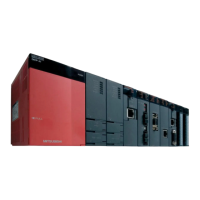4 - 53
4.6 Self-diagnostic Function
4
FUNCTIONS
4.6 Self-diagnostic Function
(1) What is self-diagnostic function?
The self-diagnostic function allows the C Controller module to check itself for errors
during normal operation in order to prevent C Controller module malfunction and to
provide preventive maintenance.
(2) Processing after error detection
The C Controller module operates as described below if it is started in the normal
operation mode and an error is detected by the self-diagnostics.
(a) ERR.LED turns on or flashes
The ERR.LED on the C Controller module front turns on or flashes.
(b) Storage and confirmation of error details
An error code is stored and the error information is changed.
The error code and error information can be confirmed by "Error code" and "Error
information" on the <<Module information>> tab of the C Controller setting
utility.( Refer to Section 9.2.2)
(c) Disabling Writes and clearing outputs
Upon detection of an error, the output (Y) from user program and writing to buffer
memory is prohibited, and the output operations to the output, I/O, and intelligent
function modules are cleared.
In the cases shown below, the C Controller setting utility allows selections
between "Stop" and "Continue" for the output (Y) from user program and writing to
buffer memory, between "Clear" and "Hold" for the output, and between "All stop"
and "Continue" for the multiple CPU system.
1) When error is detected in intelligent function module
Whether to stop or continue the output (Y) from user program and writing to
buffer memory for the error-detected intelligent function module can be
selected.
Make this setting in the "H/W error time CPU operation mode" on the <<I/O
assignment setting>> tab of the C Controller setting utility.
( Refer to Section 9.2.8)
2) Outputs to output, I/O, and intelligent function modules in event of error
detection
Whether to clear or hold the outputs to the output, I/O, and intelligent function
modules in the event of error detection can be selected.
Make this setting in the "Error time output mode" on the <<I/O assignment
setting>> tab of the C Controller setting utility. ( Refer to Section 9.2.8)
3) When fuse blown or I/O module comparison error is detected
Whether to stop or continue the output (Y) from user program and writing to
buffer memory in the above case can be selected.
Make this setting in the "Operating mode when there is an error" on the
<<System setting>> tab of the C Controller setting utility.
( Refer to Section 9.2.7)

